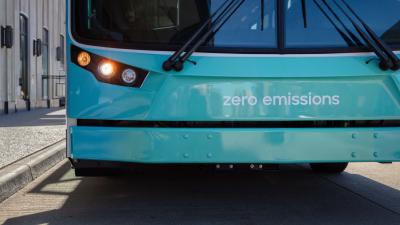ما هو تصنيف الهيدروجين ولماذا هو مفيد؟
يلعب الهيدروجين دورًا هامًا في إزالة الكربون، في ظل سعي العالم للحد من الاحتباس الحراري. ومع تزايد الاهتمام بهذا المصدر الحيوي للطاقة النظيفة، دخلت مصطلحاتٌ مُلهمةٌ مثل الهيدروجين الأخضر والأزرق والرمادي إلى قاموس مصطلحات الاستدامة المُعقدة. ولكن ما معنى نظام الترميز اللوني، وما فائدته؟
استُخدم الهيدروجين كوقود لأكثر من قرنين من الزمان. ورغم أن آلاف المركبات والآلات حول العالم تعمل اليوم بخلايا وقود الهيدروجين، إلا أن تعقيدات إنتاجه وتكلفته أعاقت اعتماده على نطاق واسع في الماضي.
الهيدروجين هو العنصر الأكثر وفرةً في الكون، ولكنه لا يتواجد طبيعيًا بمفرده. يجب إنتاجه بفصله عن عناصر أخرى، مثل الماء أو الوقود الأحفوري. هناك طرقٌ مختلفةٌ لتحقيق ذلك، وكل عمليةٍ تستهلك كمياتٍ مختلفةً من الطاقة وتُنتج انبعاثاتٍ مختلفةً من غازات الدفيئة.
باعتباره مصدرًا للطاقة النظيفة، من المهم التمييز بين الهيدروجين وطريقة الإنتاج المستخدمة لفهم الصورة الكاملة لتأثيره البيئي.
لماذا قوس قزح الهيدروجين؟
يعد قوس قزح الهيدروجين طريقة بسيطة للأشخاص الذين لا يعملون في صناعة الطاقة النظيفة أو ليسوا على دراية بها لفهم الخيارات المتاحة حول حل الطاقة المثير هذا. ومن الجدير بالذكر أن الهيدروجين كله عبارة عن غاز غير مرئي عديم اللون. لسوء الحظ، لا يوجد هيدروجين في الواقع باللون الوردي أو الأصفر أو الفيروزي في اللون المرئي.
وبدلاً من ذلك، تعتبر الألوان أداة مفيدة لتصنيف وتذكر أنواع الهيدروجين.
الألوان المستخدمة لوصف طرق الإنتاج - وإن لم تعكس الخصائص العلمية - تحمل دلالة في بعض الحالات، ودلالة عشوائية في حالات أخرى. ومن غير المستغرب أن يكون الهيدروجين الأخضر الخيار الأكثر استدامةً وأقل تأثيرًا بيئيًا. أما الهيدروجين الفيروزي، فيشتق اسمه من عملية إنتاجه التي تتراوح بين الأخضر والأزرق. ويستمر قوس قزح الهيدروجين في التوسع مع طرح أساليب إنتاج هيدروجين جديدة ومبتكرة.
الهيدروجين الأخضر
لا يحتوي الهيدروجين الأخضر على أي انبعاثات كربونية ويتم إنتاجه باستخدام مصادر الطاقة المتجددة مثل الطاقة الشمسية وطاقة الرياح والطاقة الكهرومائية لتحليل المياه بالكهرباء. تستخدم المحللات الكهربائية تفاعلًا كهروكيميائيًا لتقسيم الماء إلى مكوناته من الهيدروجين والأكسجين.
الهيدروجين الأخضر هو الهيدروجين الوحيد الذي لا ينبعث منه أي انبعاثات ضارة أثناء إنتاجه. ورغم أهمية فوائده، إلا أن إنتاجه أعلى تكلفةً ويشكل نسبةً ضئيلةً جدًا من إجمالي إنتاج الهيدروجين. ومع التطورات والابتكارات الجديدة في مجال الهيدروجين الأخضر، ستنخفض أسعاره وسيزداد استخدامه.
الهيدروجين الأخضر هو محور تركيز تقنيات التحليل الكهربائي Accelera™ من Cummins. بفضل تقنية غشاء تبادل البروتون (PEM) في محفظة منتجاتها، تُنتج أجهزة التحليل الكهربائي Accelera الهيدروجين الأخضر بنشاط في بيكانكور، كندا، مع نظام بقدرة 90 ميجاوات. في الآونة الأخيرة، أعلنت شركة Accelera عن تم تشغيل نظام بقدرة 100 ميجاوات بالشراكة مع شركة bp.
الهيدروجين الأصفر
مجموعة فرعية من الهيدروجين الأخضر، يتم إنتاج الهيدروجين الأصفر من خلال التحليل الكهربائي الناتج عن الطاقة الشمسية.
الهيدروجين الرمادي
يتم إنشاء الهيدروجين الرمادي من الغاز الطبيعي - عادة الميثان - من خلال عملية تسمى إصلاح بخار الميثان (SMR). يُشكل الهيدروجين الرمادي، وهو الشكل الأكثر شيوعًا لإنتاج الهيدروجين، 95% من إنتاج الهيدروجين في الولايات المتحدة، وهو الأقل تكلفة. لا يتم احتجاز غازات الاحتباس الحراري الناتجة عن هذه العملية.
الهيدروجين الأزرق
مثل الهيدروجين الرمادي، يعتمد الهيدروجين الأزرق على عملية SMR التقليدية.
الفرق الرئيسي يكمن في استخدام تقنية التقاط الكربون وتخزينه (CSS). تحتجز هذه التقنية ثاني أكسيد الكربون الناتج عن عملية الإصلاح وتخزنه تحت الأرض. يُخفّض هذا من الناحية الفنية عتبة الانبعاثات، إلا أن تسرب الميثان والهيدروجين المباشر من جيوب الكربون المخزنة يُثير القلق.
يُطلق على الهيدروجين الأزرق اسم منخفض الكربون بسبب CSS، ولكن لا يزال هناك جدل حول ما إذا كان استخدام SRM مع CSS يمكن اعتباره حقًا عملية "منخفضة الكربون".
هيدروجين الفيروز
أحد الألوان الأحدث التي انضمت إلى طيف الهيدروجين هو الهيدروجين الفيروزي. يقع الفيروز بين الهيدروجين الأخضر والأزرق، ويتم إنتاج الفيروز من خلال عملية تسمى الانحلال الحراري للميثان. هذه عملية ذات درجة حرارة عالية تحول الميثان إلى غاز الهيدروجين والكربون الصلب - مثل الفحم أو الكتلة الحيوية - في وجود محفز. لا يتم إنشاء أول أكسيد الكربون أو انبعاثات ثاني أكسيد الكربون.
ورغم أن الهيدروجين الفيروزي ليس له تأثير مؤكد على نطاق واسع حتى الآن، فإنه يمتلك إمكانات كحل منخفض الانبعاثات إذا تمكن العلماء من إيجاد طرق لتشغيل العملية الحرارية بالطاقة المتجددة واستخدام أو تخزين المنتج الثانوي للكربون بشكل مناسب.
الهيدروجين الوردي
يستخدم الهيدروجين الوردي الطاقة النووية لتغذية التحليل الكهربائي اللازم لإنتاجه. توفر درجات الحرارة المرتفعة للمفاعلات النووية فائدة إضافية، حيث تنتج الحرارة الشديدة بخارًا يمكن استخدامه في التحليل الكهربائي أو إصلاح غاز الميثان البخاري القائم على الغاز الأحفوري في أشكال أخرى لإنتاج الهيدروجين.
الهيدروجين البني والأسود
يمثل الهيدروجين الأسود والبني العملية التقليدية لإنتاج الهيدروجين - تحويل الفحم إلى غاز. يُطلق الفحم الأسود (الفحم الحجري والقار) كمية أقل من ثاني أكسيد الكربون لكل وحدة طاقة مُنتجة مقارنةً بالفحم البني (الليغنيت)، لكن هذا لا يعني أن تحويل الفحم الأسود إلى غاز أمر مرغوب فيه. فهو لا يزال أكثر عمليات إنتاج الهيدروجين ضررًا بالبيئة.
هيدروجين أبيض
الهيدروجين الأبيض هو هيدروجين جيولوجي طبيعي موجود في رواسب جوفية. وتستكشف الجامعات والشركات وهيئات البحث والسياسات إمكانات هذا الهيدروجين وتأثيره على استخراجه.
يُطلق على الهيدروجين الموجود طبيعيًا أيضًا اسم الهيدروجين "الذهبي"، ولكن قد ينتهي الأمر بالهيدروجين الذهبي في فئته الخاصة قريبًا. في حين لا يزال هناك جدل حوله، فإن هيدروجين الذهب هو استخراج الهيدروجين من تخمير الميكروبات الموجودة في آبار النفط المستنفدة.
تأثير قوس قزح
يُمكن للهيدروجين أن يُوفر مصدر وقود نظيف وتدفئةً للمنازل ووسائل النقل والصناعة. إلا أن خصائصه البيئية تختلف باختلاف طريقة إنتاجه. ورغم انتقاد البعض لقوس قزح لتبسيطه المفرط لتفاصيل عمليات الإنتاج، إلا أنه بلا شك ساعد الناس على التعرّف على الخيارات المتاحة ومزاياها وعيوبها. وقد سهّلت الألوان تذكر هذه الرسائل المُعقدة، وتحديد الخيارات الأفضل، وفهم حل جديد ومثير للطاقة النظيفة بشكل أفضل.

